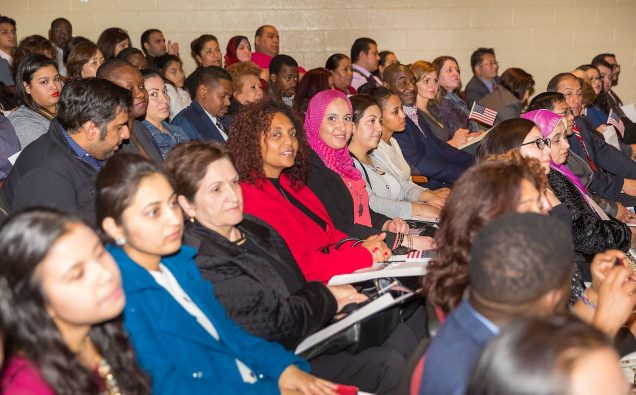
A naturalization ceremony in Vienna, Virginia, December 2015, Photo: Department of Labor/Wikipedia
A new study released on the eve of Supreme Court’s hearing of the travel ban case highlights the socioeconomic contributions of immigrants from countries affected by the restriction.
Based on data collected from a variety of sources, and taking into account previous studies with opposing findings, “A Profile of Immigrants from Travel Ban-Affected Countries in the United States” explains that the travel ban could potentially affect the lives of many people hoping to study, travel, live, or work in the United States.
“Many of the immigrants from these travel ban-affected countries already living here are naturalized U.S. citizens; they are employed and highly educated; and they own homes,” notes Professor James Witte, head of George Mason University’s Institute for Immigration Research www.iir.gmu.edu.
The ban, he explains, “has the potential to negatively impact these immigrant communities and the states and cities in which they live and work.”
The U.S. Supreme Court will Wednesday hear oral arguments on the case of Trump v. Hawaii, which challenges the proclamation bars certain nationals from Iran, Libya, North Korea, Somalia, Syria, Venezuela, and Yemen from entering the United States.
The White House has argued that the travel restrictions enacted on September 24, 2017, have been put in place as a national security measure since these countries do not have necessary data sharing systems.
The report, sourced from data, says immigrants from the affected countries are “typically employed, highly educated, have high incomes, are homeowners, and make economic contributions to the United States.”
“The social and economic contributions made by these immigrants did not occur overnight. With time these immigrants overcame challenges to make significant contributions to the United States. All of this suggests that barring future nationals from these countries could have a negative economic and social impact on the United States, says author of the report, Mohammad Ismail Nooraddini, who is pursuing his PhD in Sociology at George Mason University.
Here are some of the key findings of the Report as released by the Institute for Immigration Research:
“Foreign-born individuals from travel ban-affected countries represent a small portion of the U.S. population. Approximately 799,300 immigrants living in the United States are from one of the travel ban-affected countries, an overall increase of nine percent since 1980. This group represents 0.25 percent of the U.S. population. In other words, for every 1,000 people in the United States, 2.5 are immigrants from Iran, Libya, North Yemen, Somalia, Syria, or Venezuela. For comparison’s sake, there are a total of 134 foreign-born individuals for every 1,000 people in the United States.
“Over half of immigrants from travel ban-affected countries are U.S. citizens. Approximately 61 percent of foreign-born individuals from the travel ban-affected countries are naturalized citizens.
“Immigrants from travel ban-affected countries have higher rates of educational attainment compared to all other immigrants living in the United States and native-born U.S. citizens. Nearly half of foreign born individuals 25 years of age and older from a travel ban-affected country have either a bachelor’s, graduate, and/or doctoral degree (46 percent), compared to under one-third of all other immigrants (28 percent) and native-born U.S. citizens (30 percent).
A vast majority of immigrants from the travel ban-affected countries are employed, with nearly two-in-ten reporting self-employment. Ninety percent of foreign-born individuals from travel ban-affected countries age 16 to 65 report being employed. Of those employed, approximately 18 percent are self-employed.
Immigrants from travel ban-affected countries are most likely to work in occupational groups related to engineering, science, and entertainment. The occupational groups with the highest share of immigrants from the travel ban-affected countries include architecture and engineering; life, physical, and social science; and sales. Immigrants from travel ban-affected countries tend to be dentists; miscellaneous media and communication workers (including translators and interpreters), biomedical and agricultural engineers; physicians and surgeons; and civil engineers.
Households headed by immigrants from travel ban-affected countries tend to report greater median family incomes compared to households headed by native-born U.S. citizens. Immigrant household heads from travel ban-affected countries with a household size of three report a median annual household income of $70,240; an income that tops similarly sized households headed by native-born U.S. citizens by an estimated $4,000.
Over the past 30 years, immigrants from these countries have contributed civically, socially, and economically. Since 1980, nearly 700,000 immigrants from these countries entered the United States.
During this time, foreign-born individuals from the travel ban-affected countries have experienced increases in the rate of citizenships (61 percent versus 20 percent), educational attainment (46 percent versus 37 percent), property ownership (46 percent versus 38 percent), and median annual household income ($70,240 versus $46,848).”














